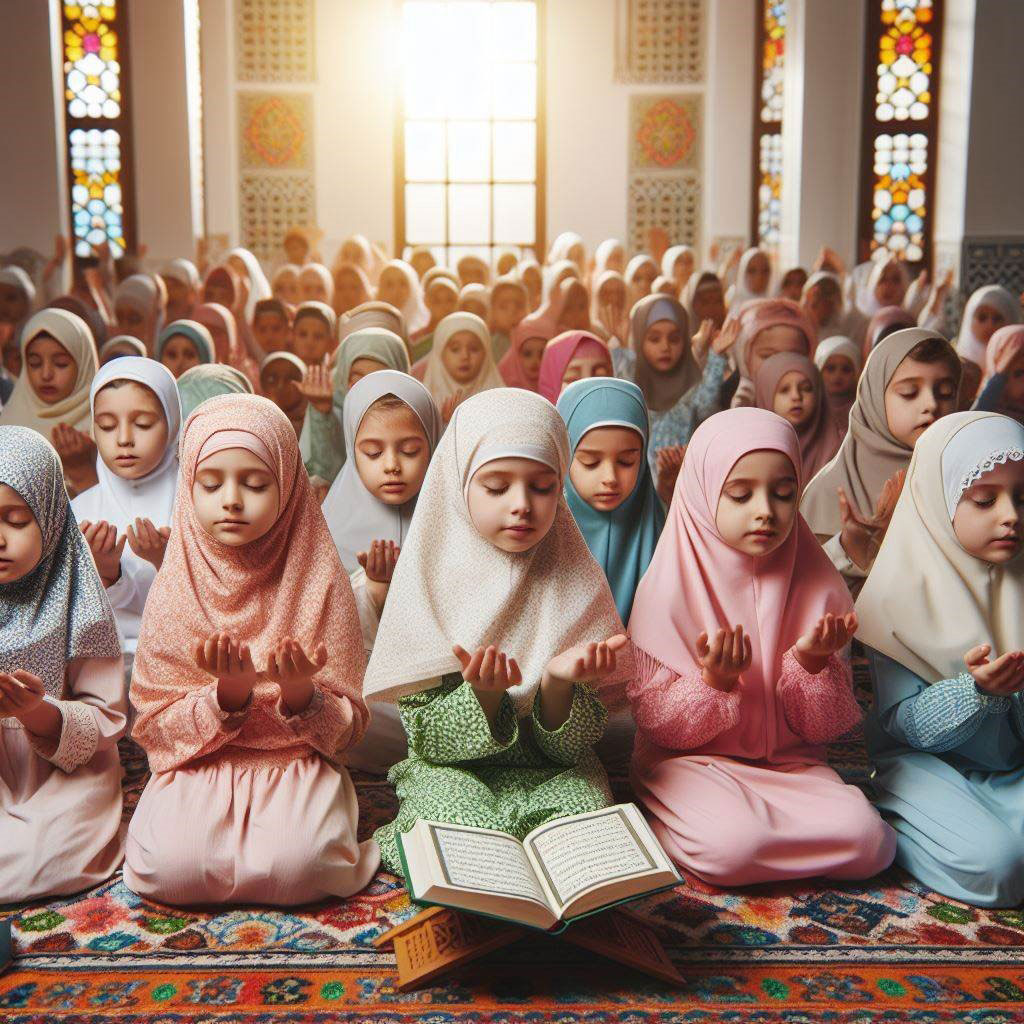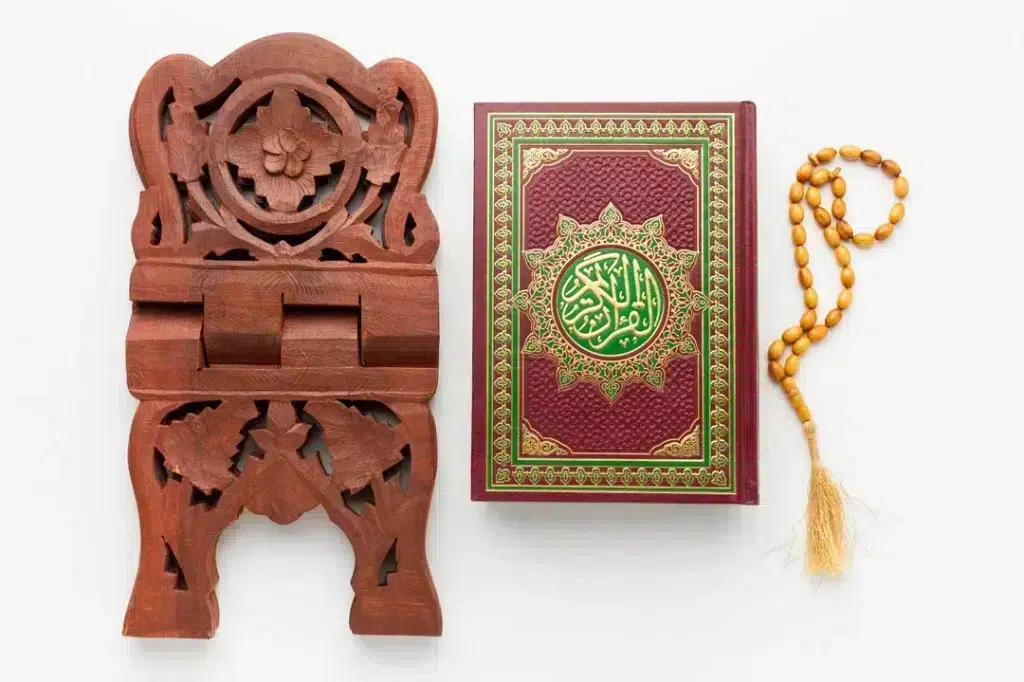The parable of my Ahl al-Bayt is similar to that of Noah’s Ark. Whosoever embarks it will certainly get rescued, but he who refuses to board it will surely get drowned.
Prophet Muhammad (S)
Table of Contents
ToggleTarteel recitation in the Heavenly Quran refers to the slow, measured, and melodious way of reciting the verses.
It involves a deep understanding of the pronunciation and proper delivery of the sacred text.
Importance of Tarteel Recitation in the Holy Quran
Preservation
The Sacred Quran is not just a religious scripture for Muslims; it is the verbatim word of Allah revealed to Prophet Muhammad (S) through the Angel Gabriel over a period of 23 years.
As such, it holds immense significance and is considered a divine guide for Muslims worldwide.
One of the key aspects that contribute to the preservation and understanding of Quran is its recitation, specifically the practice of Tarteel.
Tarteel is an Arabic term derived from the root word “ratil,” which means to recite slowly and in a measured tone.
It is an essential component of Quranic recitation that emphasizes clarity, articulation, and reverence for the divine text.
The importance of Tarteel recitation in preserving the Noble Quran lies in its role in enhancing comprehension, preserving the correct pronunciation and intonation, and transmitting the true essence of Quran’s message to the reader.
First and foremost, Tarteel recitation is crucial for promoting a deeper understanding of the Quranic text.
The deliberate and measured pace of recitation helps the listener or reader to focus on each word, phrase, and verse, enabling them to reflect upon its meaning and ponder over the divine wisdom contained within.
The Grand Quran itself invites believers to reflect and contemplate its verses, as it states, “Then do they not reflect upon the Glorious Quran?
If it had been from [any] other than Allah, they would have found within it much contradiction” (Quran 4:82). Tarteel recitation allows individuals to engage intellectually and emotionally with the Holy Quran, fostering a profound connection to the divine message and reinforcing its significance in their lives.
Furthermore, the practice of Tarteel recitation ensures the preservation of the correct pronunciation and intonation of the Sacred Quran.
The Arabic language has a unique phonetic system, and even minor errors in pronunciation can alter the meaning of words and verses. This is particularly crucial in preserving the Quranic text precisely as it was revealed.
Tarteel recitation requires meticulous attention to detail by reciters, ensuring proper enunciation of each letter, vowel, and pause in accordance with the rules of Tajwid .
Tajwid is the set of guidelines that govern the correct pronunciation of Arabic letters and their articulation, emphasizing the beauty and excellence of Quranic recitation.
By adhering to Tarteel recitation, Quran’s original phonetic and poetic structure is maintained, guarding against any unintentional alterations or misinterpretations.
Additionally, Tarteel recitation plays an integral role in transmitting the true essence of Quran’s message.
The Holy Quran is not merely a book of guidance; it is a means of communication between Allah and humanity. The melodic and rhythmic quality of Tarteel recitation enhances the emotional impact of the Grand Quran’s verses, allowing the listener or reciter to experience its spiritual and transformative power.
Through the skillful use of voice modulation and intonation, reciters can evoke a range of emotions, such as awe, humility, gratitude, and repentance, thereby enabling individuals to connect with the divine message on a deeper level.
The ethical and moral teachings of the Holy Quran are effectively conveyed through Tarteel recitation, enabling believers to internalize and embody these principles in their lives.
Spiritual Connection
Tarteel is the art of slow and melodious recitation of the Sacred Quran, paying attention to the proper enunciation and pronunciation of each word. This method of recitation has a deep spiritual significance for Muslims, as it enhances the experience of engaging with the divine message.
The importance of Tarteel recitation lies in its ability to facilitate a stronger spiritual connection between the reciter and the Glorious Quran.
First and foremost, Tarteel recitation allows for a more profound understanding of the Quranic verses.
By reciting the verses in a slow and deliberate manner, the reciter is able to capture the nuance and beauty of the language employed in the Noble Quran.
The poetic nature of the Quranic scripture is elevated through the Tarteel style, enabling the reciter to appreciate the depth of meaning behind each verse. This deeper understanding has a transformative effect on the reciter, leading to a greater spiritual connection with the words of God.
Furthermore, Tarteel recitation enables the reciter to fully immerse themselves in the Quranic experience.
The slow and deliberate recitation allows for contemplation and reflection on the verses being recited. This contemplative state of mind is essential for spiritual growth and connection.
As the reciter ponders over the words of the Sacred Quran, they are able to internalize its teachings and apply them to their daily lives.
This process of reflection and application deepens the spiritual connection with God and strengthens the individual’s faith.
Additionally, Tarteel recitation serves as a means of seeking solace and tranquility.
The melodious sounds produced during the recitation have a soothing effect on the reciter, creating a sense of peace and calmness.
This spiritual serenity is essential in navigating the challenges and turmoil of life. By engaging in Tarteel recitation, individuals find solace and comfort in the divine words, allowing them to find guidance and strength amidst adversity.
This connection with the Sacred Quran helps believers to overcome trials and tribulations, fostering a stronger spiritual bond with God.
The importance of Tarteel recitation extends beyond the individual reciter. It serves as a unifying force for the Muslim community, fostering a collective spiritual connection.
The act of reciting the Holy Quran together in a melodious and synchronized manner during congregational prayers creates a sense of harmony and unity amongst worshippers.
This collective recitation uplifts the souls of believers, reinforcing their shared faith and sense of belonging.
The communal aspect of Tarteel recitation promotes a cohesive and inclusive spiritual community, enriching the overall spiritual experience for all Muslims.

Emotional Impact
One of the main aspects that make tarteel recitation emotionally impactful is the soothing and melodious nature of the recitation.
When one hears the Noble Quran being recited in a rhythmic and beautiful manner, it creates a peaceful and calming environment. The melodious tone of the recitation has a profound effect on the listener’s emotions, invoking feelings of tranquility, serenity, and a sense of connection with the divine.
This emotional impact is not only beneficial for individuals seeking solace and comfort but also aids in building a deeper spiritual connection with the words of Allah.
Moreover, tarteel recitation adds depth and meaning to the verses of the sacred Quran.
By reciting the Glorious Quran in a rhythmic manner, the reciter brings out the beauty and eloquence of the words. The emotional impact of tarteel lies in its ability to highlight the poetic and linguistic aspects of the Grand Quran, engaging the listener on a deeper level.
The rhythm and melody employed in tarteel recitation emphasize the different nuances and emotions conveyed by the verses, allowing for a more profound understanding and appreciation of the message being conveyed.
This emotional connection created through tarteel recitation enhances the impact of the Quranic verses, making them more relatable and meaningful to the listener.
Furthermore, tarteel recitation helps in retaining and memorizing the Noble Quran.
The rhythmic and melodic nature of tarteel aids in the memorization process, enabling individuals to commit the verses to memory more effectively. The emotional impact of tarteel plays a vital role here as it captures the listener’s attention and helps create a stronger connection to the words being recited.
This emotional engagement enhances the memorization process by enabling individuals to associate the verses with the emotions felt during the recitation.
Consequently, tarteel recitation becomes a means of preserving the message of the Sacred Quran in the hearts and minds of Muslims.
In addition to its impact on individuals, tarteel recitation holds social and communal significance.
The emotional impact of tarteel often transcends individual experiences and creates a sense of unity among Muslims. When a group of people recites the Noble Quran with tarteel, the collective emotion evoked brings about a feeling of togetherness and strengthens the bond within the community.
Tarteel recitation becomes an act of worship that not only connects individuals to their faith but also connects them to each other, fostering a sense of unity and harmony.
Techniques and Rules of Tarteel Recitation
Articulation
The Holy Quran itself describes the importance of articulation and clear pronunciation in its recitation. It states, “Verily, we have sent it down in the clear Arabic language” (Surah Yusuf, 12:2).
This verse highlights the clarity and precision of the Arabic language, emphasizing the need for appropriate articulation when reciting the Glorious Quran.
In Tarteel recitation, the rules of articulation are of utmost importance. The reciter must pronounce each letter distinctly and accurately, paying attention to the points of articulation.
These points of articulation include the throat, tongue, lips, and nasal passage. The reciter must master the correct pronunciation of each letter and its proper placement within a word or phrase.
One of the most common articulation techniques in Tarteel recitation is known as Tajwid. Tajwid is the science of reciting the sacred Quran correctly, adhering to the rules and guidelines set by the Prophet Muhammad (S) and his companions.
Tajwid focuses on the phonetics, intonation, and rhythm of recitation, ensuring that each letter is pronounced correctly, with the appropriate length, stress, and pause.
Proper articulation in Tarteel recitation also involves the correct pronunciation of vowels and elongations. In Arabic, there are specific rules for elongating certain vowels and the correct pronunciation of the short vowels.
These rules help to maintain the rhythm and flow of the recitation while conveying the proper meaning and pronunciation of the words.
Additionally, correct articulation in Tarteel recitation requires proper pronunciation of the sound qualities of letters.
In Arabic, there are letters known as “heavy” and “light” letters, which require different articulation techniques.
The heavy letters require more pressure and effort in their pronunciation, while the light letters are pronounced with a more relaxed and gentle articulation.
Articulation in Tarteel recitation also involves the correct pronunciation of the various Arabic sounds.
Arabic has distinct sounds that differ from other languages, such as the guttural sounds like “ayn” and “ghayn.” These particular sounds require proper articulation from the throat to produce the desired effect.
Rhythmic Flow
Rhythmic flow serves as a foundation for Tarteel recitation and plays a significant role in captivating the hearts and minds of listeners.
It entails a consistent and harmonious movement of sound in a pattern that cadences with the natural rhythm of human speech.
It allows the reciter to establish a connection not only with the content of the Sacred Quran but also with the audience, creating a mesmerising experience.
The rhythmic flow is achieved through the understanding of the structure and patterns embedded within the Arabic text.
One of the defining features of Tarteel recitation is its measured pace.
It is not a hurried reading; rather, it is deliberate and carefully orchestrated to maintain an equilibrium between speed, rhythm, and clarity.
Reciters strive to strike a balance between moving forward in the recitation while ensuring every word is distinctly pronounced and absorbed by the listener.
This deliberate rhythm creates an aura of tranquility and serenity that draws the audience into the recitation.
Furthermore, the rhythmic flow in Tarteel recitation is achieved by adhering to the rules of madd (elongation) and qalqalah (the echoing effect).
Madd refers to lengthening specific vowel sounds, primarily vowels ‘alif’, ‘waw,’ and ‘ya.’ This elongation adds depth and resonance to the recitation, enhancing its aesthetic appeal.
Qalqalah, on the other hand, produces a subtle echoing effect by slightly emphasizing certain consonants, primarily ‘ta,’ ‘ba,’ ‘jeem,’ ‘dal,’ and ‘qaf.’ This echoing effect brings an added layer of rhythm and melody to the recitation, heightening its emotional impact.

Additionally, the rhythmic flow in Tarteel recitation is influenced by the prosody of Arabic, known as tajwid.
Tajwid encompasses rules and regulations that govern the correct pronunciation and articulation of each letter and word in the Noble Quran.
By following the principles of tajwid, reciters ensure a coherent and consistent rhythmic flow throughout their recitation.
These rules include enunciating letters with proper emphasis, pausing at appropriate places, and transitioning smoothly between verses and chapters.
The rhythmic flow in Tarteel recitation not only enhances the auditory experience but also aids in memorization and comprehension of the Glorious Quran.
The consistent cadence and repetition of verses create a melodic pattern that facilitates the retention of the text in the memory.
Additionally, the measured pace and deliberate pronunciation allow listeners to grasp the meanings embedded within the words and reflect upon their significance.
Understanding
To achieve the proper delivery in tarteel recitation, it is essential for the reciter to understand the meaning of the verses being recited.
This understanding allows the reciter to feel the emotions conveyed in the Holy Quran and to convey those emotions to the listeners effectively.
Without understanding, the recitation may become monotonous and lack the intended impact.
One of the rules of tarteel recitation is to recite the Qur’an with proper Tajwid, which refers to the correct pronunciation and articulation of each letter and word.
Tajwid allows the reciter to adhere to the rules of recitation, ensuring that the words are pronounced as they should be.
This further highlights the significance of understanding as tarteel requires the reciter to comprehend the meanings of the words in order to pronounce them correctly.
Furthermore, understanding aids the reciter in applying the appropriate tone, melody, and rhythm to the recitation.
Each verse in the Noble Quran carries a unique meaning and message, and understanding allows the reciter to embody and express these messages through their voice.
For example, verses that convey a sense of hope and mercy may be recited with a softer tone and a slower pace, while verses that discuss punishment and warning may be recited with a stronger tone and a faster pace.
Understanding the context and meaning of the verses empowers the reciter to deliver the intended emotions to the listeners.
The significance of understanding in tarteel recitation is also emphasized in the hadith of Prophet Muhammad (S). He said, “The best of you are those who learn the Noble Quran and teach it to others.”
This hadith encourages Muslims to not only recite the Sacred Quran but also to understand its meanings and impart that knowledge to others. By doing so, they uphold the true essence of tarteel recitation and play a vital role in preserving the beauty of the Glorious Quran.
Common Misconceptions About Tarteel Recitation
Speed
One of the most prevalent misconceptions is that tarteel must be recited at an extremely slow pace, to the point where even a single verse may take several minutes to complete.
This misconception can be attributed to cultural practices in some Muslim-majority regions, where religious leaders or Quran teachers emphasize a snail-like pace during recitation.
While it is important to recite at a measured pace, excessive slowness can lead to a loss of engagement and attentiveness, defeating the purpose of tarteel.
Another misconception is that tarteel is only for advanced Quran reciters or those with a melodious voice.
This notion is further reinforced by the common belief that tarteel is primarily for professional reciters who lead the prayers in mosques.
This misconception overlooks the fact that tarteel is actually encouraged for all individuals, regardless of their level of expertise or voice quality.
The fundamental purpose of tarteel is to allow for a deep understanding and contemplation of the Quranic verses, irrespective of the individual’s skill level or voice type.
Furthermore, there is a misconception that tarteel is a rigid and inflexible form of recitation.
This misunderstanding stems from the mistaken belief that tarteel requires adhering strictly to a predetermined speed or rhythm.
In reality, tarteel allows flexibility and variation in recitation, as long as it maintains the essence of deliberate pacing and proper articulation.
It is not about reciting every verse at the exact same speed, but rather about finding a balance that allows for clarity, comprehension, and connection with the content of the Grand Quran.
Another common misconception is that tarteel is only meant for personal recitation and not for public gatherings or congregational prayers.
This view disregards the fact that tarteel is not limited to individual readings but can also be applied in communal settings. In fact, tarteel can enhance the collective experience of reciting the Noble Quran by allowing the participants to collectively absorb and reflect on the divine message.
The measured pace of tarteel helps to create an atmosphere that fosters attentiveness and spiritual connection.

Complexity
Firstly, the complexity of tarteel lies in its unique style and structure. Tarteel recitation involves the melodious and rhythmic delivery of the Quranic verses, with an emphasis on precise pronunciation, enunciation, and adherence to the rules of recitation known as Tajwid.
This level of precision requires years of practice, guidance from experienced reciters, and a deep understanding of the Arabic language.
Due to its complexity, many people mistakenly assume that tarteel recitation is simply a matter of reading verses aloud, failing to see the meticulous effort and training that underlie this oral tradition.
Furthermore, misconceptions surrounding tarteel recitation often arise from the perception that it is an exclusively performative art form.
While the melodious aspect of tarteel is indeed captivating and aesthetically pleasing, it is essential to understand that the primary goal of tarteel is not mere entertainment but rather an act of worship and seeking a spiritual connection with the divine.
This complexity is often overlooked, leading to misunderstandings regarding the purpose and significance of tarteel recitation.
Another factor contributing to misconceptions about tarteel is the belief that it is reserved only for a select few.
This misconception arises from the misconception that tarteel is an innate talent, rather than a skill that can be learned and developed.
The perception that only those with a natural inclination or gifted voice can truly master tarteel leads to a sense of exclusion and discouragement among those who aspire to engage in tarteel recitation.
However, it is crucial to remember that with dedication, practice, and proper guidance, individuals can acquire and refine the necessary skills to become proficient in tarteel recitation.
Moreover, the complexity of tarteel recitation often leads to the misconception that it is primarily a superficial form of worship, devoid of deeper understanding and reflection on the Quranic verses.
This misconception arises from the belief that the focus on the melodious delivery overshadows the importance of comprehending the message conveyed by the Sacred Quran.
However, tarteel is meant to enhance the spiritual experience and facilitate a deeper connection with the words of Allah. It is a means to ensure that the listener is not only captivated by the beauty of the recitation but also encouraged to ponder upon and internalize the profound meanings contained within the verses.

Linguistic Expertise
One of the misconceptions often encountered is the belief that tarteel recitation requires understanding the Arabic language.
While it is true that knowledge of Arabic can enhance the recitation experience, it is not a prerequisite for practicing tarteel. Tarteel recitation aims to capture the unique rhythmic and melodic qualities within the Quranic verses, regardless of the reciter’s language proficiency.
In fact, tarteel can also be performed by non-Arabic speakers who are committed to learning the correct pronunciation and delivery of the verses
In conclusion Tarteel recitation is an integral part of the Islamic tradition embodying the beauty depth and spirituality of the Noble Quran.
Its historical significance meticulous techniques and profound impact on the Muslim community make it a captivating and cherished art form.
By engaging in Tarteel recitation Muslims can deepen their connection with the divine message of Quran find solace and tranquility and preserve the oral tradition for generations to come.

















